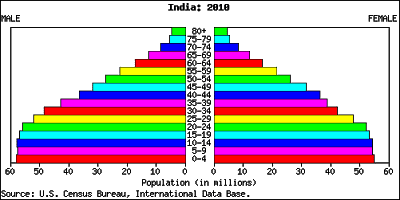Human resource is the ultimate resource. Healthy, educated and motivated people develop resources as per their requirements.Human resources like other resources are not equally distributed over the world. They differ in their educational levels, age and sex. Their numbers and characteristics also keep changing. The Government of India has a Ministry of Human Resource Development.The Ministry was created in 1985 with an aim to improve people’s skills. This just shows how important people are as a resource for the country. It is a realized fact that managing the human resource, to make it productive is one of the most challenging tasks in front of all countries in the world.
Pattern of population distribution : The way in which people are spread across the earth surface is known as the pattern of population distribution. More than 90 per cent of the world’s population lives in about 10 per
cent of the land surface. The distribution of population in the world is extremely uneven. Some areas are very crowded and some are sparely populated. The crowded areas are south and south east Asia, Europe and north
eastern North America. Very few people live in high latitude areas, tropical deserts, high mountains and areas of equatorial forests.Many more people live north of the Equator than south of the Equator. Almost three-quarters of the world’s people live in two continents Asia and Africa. Sixty per cent of the world’s people stay in just 10 countries. All of them have more than a 100 million people.
Density of population : Population density is the number of people living in a unit area of the earth’s surface. It is normally expressed as per square km. The average density of population in the whole world is 45 persons per square km. South Central Asia has the highest density of population followed by East and South East Asia. Average density of population in India is 324 persons per square km.
Geographical Factors Affecting Distribution of Population
Topography: People always prefer to live on plains rather than mountains and plateaus because these areas are suitable for farming, manufacturing and service activities. The Ganga plains are the most densely populated areas of the world while mountains like Andes, Alps and Himalayas are sparsely populated.
Climate: People usually avoid extreme climates that are very hot or very cold like Sahara desert, polar regions of Russia, Canada and Antarctica.
Soil: Fertile soils provide suitable land for agriculture. Fertile plains such as Ganga and Brahmaputra in India, Hwang-He, Chang Jiang in China and the Nile in Egypt are densely populated.
Water: People prefer to live in the areas where fresh water is easily available. The river valleys of the
world are densely populated while deserts have spare population.
Minerals: Areas with mineral deposits are more populated. Diamond mines of South Africa and discovery of oil in the Middle east lead to settling of people in these areas.
Social Factors : Areas of better housing, education and health facilities are more densely populated e.g., Pune.
Cultural: Places with religion or cultural significance attract people. Varanasi, Jerusalem and Vatican city
are some examples.
Economic: Industrial areas provide employment opportunities. Large number of people are attracted to these areas. Osaka in Japan and Mumbai in India are two densely populated areas.
Population Change : The population change refers to change in the number of people during a specific time.
In 1820, the world’s population reached one billion. A hundred and fifty years later, in the early 1970s, the
world’s population reached 3 billion. This is often called population explosion. In 1999, less than 30 years later, the population doubled to 6 billion. The main reason for this growth was that with better food supplies and medicine, deaths were reducing, while the number of births still remained fairly high. The difference between the birth rate and the death rate of a country is called the natural growth rate. The population increase in the world is mainly due to rapid increase in natural growth rate.
Life expectancy : It is the number of years that an average person can expect to live.
Immigration and Emigration : Emigrants are people who leave a country; Immigrants are those who arrive in a country. Countries like the United States of America and Australia have gained in-numbers by in-migration or
immigration. Sudan is an example of a country that has experienced a loss in population numbers due to
out-migration or emigration.The general trend of international migrations is from the less developed nations to the more developed nations in search of better employment opportunities. Within countries large number of people may move from the rural to urban areas in search of employment, education and health facilities.
Population Pyramid : A population pyramid (age structure diagram) is a graphical illustration that shows the distribution of various age groups in a population. The shape of the population pyramid tells the story
of the people living in that particular country. The numbers of children (below 15 years) are shown at the
bottom and reflect the level of births. The size of the top shows the numbers of aged people (above 65 years)
and reflects the number of deaths. The population pyramid also tells us how many dependents there are in a country. There are two groups of dependents — young dependents (aged below 15 years) and elderly dependents (aged over 65 years). Those of the working age are the economically active. The population pyramid of a country in which birth and death rates both are high is broad at the base and rapidly narrows towards the top. This is because although, many children are born, a large percentage of them die in their infancy, relatively few become adults and there are very few old people. This situation is typified by the pyramid shown for Kenya.
In countries where death rates (especially amongst the very young) are decreasing, the pyramid is broad in the younger age groups, because more infants survive to adulthood. This can be seen in the pyramid for India. Such populations contain a relatively large number of young people and which means a strong and expanding labour force. In countries like Japan, low birth rates make the pyramid narrow at the base. Decreased
death rates allow numbers of people to reach old age. Skilled, spirited and hopeful young people endowed with a positive outlook are the future of any nation. We in India are fortunate to have such a resource. They must be educated and provided skills and opportunities to become able and productive.
Population Pyramid of India - 2010
Population Pyramid of India - 2050








0 comments: